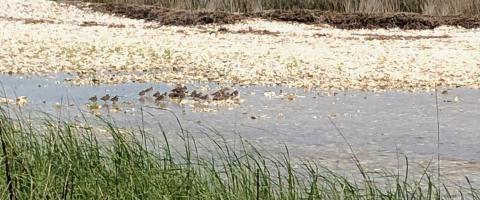The Mississippi Trustee Implementation Group is beginning the process of restoration planning for our Restoration Plan 5 and would like your input regarding natural resource restoration project ideas in the Mississippi Restoration Area. We encourage you to review our restoration progress to date on the Mississippi Restoration Area page.
Restoration Types in Restoration Plan 5 may include:
- Wetlands, Coastal, and Nearshore Habitats
- Nutrient Reduction
- Oysters
- Sea Turtles
- Marine Mammals
- Birds
Details about the Restoration Types and Approaches we are considering, including the location of related information in the Trustees’ Programmatic Restoration Plan, are all below.
Restoration Plan 5 Types and Approaches
As we begin our next planning phase, we would like to get your input on potential project ideas for the following Restoration Types and corresponding Approaches.
Wetlands, Coastal and Nearshore Habitats Restoration Type include the following restoration approaches:
- Create, restore and enhance coastal wetlands
- Restore oyster reef habitat
- Create, restore, and enhance barrier and coastal islands and headlands
- Restore and enhance dunes and beaches
- Restore and enhance submerged aquatic vegetation
-
Protect and conserve marine, coastal, estuarine, and riparian habitats
See Programmatic Restoration Plan Sections 5.5.2; 5.D.1.
Nutrient Reduction (Nonpoint source) Restoration Type restoration approaches:
- Reduce nutrient loads to coastal watersheds
- Reduce pollution and hydrologic degradation to coastal watersheds
- Create, restore, and enhance coastal wetlands
-
Protect and conserve marine, coastal, estuarine, and riparian habitats
See Programmatic Restoration Plan Sections 5.5.4; 5.D.2
Oysters Restoration Type restoration approaches:
-
Restore oyster reef habitat
See Programmatic Restoration Plan Sections 5.5.9; 5.D.1
Sea Turtles Restoration Type restoration approaches:
- Reduce sea turtle bycatch in commercial fisheries through identification and implementation of conservation measures
- Reduce sea turtle bycatch in commercial fisheries through enhanced training and outreach to the fishing community
- Enhance sea turtle hatchling productivity and restore and conserve nesting beach habitat
- Reduce sea turtle bycatch in recreational fisheries through development and implementation of conservation measures
- Reduce sea turtle bycatch in commercial fisheries through enhanced state enforcement to improve compliance with existing requirements
- Increase sea turtle survival through enhanced mortality investigation and early detection of and response to anthropogenic threats and emergency events
-
Reduce injury and mortality of sea turtles from vessel strikes
See Programmatic Restoration Plan Sections 5.5.10, 5.D.4
Marine Mammals Restoration Type restoration approaches:
- Reduce commercial fishery bycatch through collaborative partnerships
- Reduce injury and mortality of bottlenose dolphins from hook and line fishing gear
- Increase marine mammal survival through better understanding of causes of illness and death as well as early detection and intervention for anthropogenic and natural threats
- Measure noise to improve knowledge and reduce impacts of anthropogenic noise on marine mammals
- Reduce injury, harm, and mortality to bottlenose dolphins by reducing illegal feeding and harassment activities
- Reduce marine mammal takes through enhanced state enforcement related to the Marine Mammal Protection Act
- Reduce injury and mortality of marine mammals from vessel collisions
-
Protect and conserve marine, coastal, estuarine, and riparian habitats
See Programmatic Restoration Plan Sections 5.5.11, 5.D.5
Birds Restoration Type restoration approaches:
- Restore and conserve bird nesting and foraging habitat
- Create, restore, and enhance coastal wetlands
- Restore and enhance dunes and beaches
- Create, restore, and enhance barrier and coastal islands and headlands
- Restore and enhance submerged aquatic vegetation
- Protect and conserve marine, coastal, estuarine, and riparian habitats
- Establish or re-establish breeding colonies
-
Prevent incidental bird mortality
See Programmatic Restoration Plan Sections 5.5.12, 5.D.6
Submit Your Project Ideas
We encourage you to submit new restoration project ideas or make revisions to previously submitted project ideas in either of the two project submission portals listed below:
- Trustee Council Project Submission Portal
- Mississippi Department of Environmental Quality Restoration Project Idea Portal
We request that all project ideas be submitted no later than June 7, 2024. We will consider all project ideas submitted or updated between January 1, 2018, and June 7, 2024, as part of Restoration Plan 5. More information about Restoration Types in general, as well as the Oil Pollution Act criteria against which project ideas will be evaluated, can be found in the Trustees’ Programmatic Restoration Plan.
Thank you for your engagement in this process. We look forward to considering your restoration project ideas.
Get future updates delivered directly to your inbox. Subscribe today for Gulf Spill Restoration news and updates.


